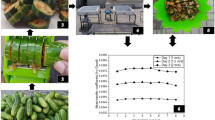Abstract
The results obtained from a drying experiment using infrared heating are compared to those obtained from an analytical model based on correlations for the mass transfer coefficients, which are commonly used to obtain evaporation rates for drying applications. It was shown that the mass transfer coefficients calculated by natural convection correlations are approximately ten times lower than those measured under infrared (IR) exposure. In an attempt to explain this discrepancy, which has been also observed in other studies and explained on the basis of thermal radiation effects, optical properties of the solvent are presented and the implications of the IR and near infrared (NIR) spectrum on the thermal radiation effects and ensuing evaporation rates are discussed. The results show that the correlation for mass transfer coefficient has to take into account the IR radiation temperature and the surface emissivity. This study provides important evaporation data on mass flux and mass transfer coefficients, which cannot be predicted using traditional correlations, for the design of IR assisted drying systems.





Similar content being viewed by others
References
Bouyer D, Werapun W, Pochat-Bohatier C, Deratani A (2010) Morphological properties of membranes fabricated by VIPS process using PEI/NMP/water system: SEM analysis and mass transfer modelling. J Membr Sci 349:97–112
Wood DL, Li J, Daniel C (2015) Prospects for reducing the processing cost of lithium ion batteries. J Power Sources 275:234–242
Onwude DI, Hashim N, Abdan K, Janius R, Chen G (2018) Heat Mass Transf 54:2917. https://doi.org/10.1007/s00231-018-2338-y
EL-Mesery HS, Abomohra A-F, Kang C-U, Cheon J-K, Basak B, Jeon B-H (2019) Evaluation of infrared radiation combined with hot air convection for energy-efficient drying of biomass. Energies 12:2818
Seyed-Yagoobi J, Husain AN (2001) Experimental and theoretical study of heating/drying of moist paper sheet with a gas-fired infrared emitter. Journal of Heat Transfer-Transactions of the ASME 123:711–718
Allanic N, Salagnac P, Glouannec P (2007) Convective and radiant drying of a polymer aqueous solution. Heat Mass Transf 43:1087–1095
Chilton TH, Colburn AP (1934) Mass transfer (absorption) coefficients. Ind Eng Chem 26(11):1183–1187
M Rosler; E Klinke; G Kunz, Drying of organic coatings by infrared radiation of different wavelengths, RadTech Europe Conference and Exhibition 1995 on Radiation Curing, Maastricht, Netherlands, Sept. 25–27, 1995, Conference Proceedings of RADTECH Europe 95, pp 462–468
Chen JJ, Lin JD (1998) Simultaneous heat and mass transfer in polymer solutions exposed to intermittent infrared radiation heating. Numerical Heat Transfer Part A-Applications 33:851–873
Boukadida N, Nasrallah SB (2001) Mass and heat transfer during water evaporation in laminar flow inside a rectangular channel — validity of heat and mass transfer analogy. Int J Therm Sci 40:67–81
Jaturonglumlert S, Kiatsiriroat T (2010) Heat and mass transfer in combined convective and far-infrared drying of fruit leather. J Food Eng 100:254–260
Langan JR, Salmon GA (1987) Physical properties of N-methylpyrrolidinone as functions of temperature. J Chem Eng Data 32(4):420–422
Kneisl P, Zondlo JW (1987) Vapor-pressure, liquid density, and the latent-heat of vaporization as functions of temperature for 4 dipolar aprotic-solvents. J Chem Eng Data 32:11–13
Grujicic M, Chittajallu KM, Walsh S (2003) Optimization of the VARTM process for enhancement of the degree of devolatilization of polymerization by-products and solvents. J Mater Sci 38:3729–3739
Shui H, Wang Z, Gao J (2006) Examination of the role of CS2 in the CS2/NMP mixed solvents to coal extraction. Fuel Process Technol 87:185–190
G.E. Jellison, Jr. and F.A. Modine, “Two-Modulator Generalized Ellipsometry: Experiment and Calibration,” Applied Optics 36, 8184–8189 (1997); “Two-Modulator Generalized Ellipsometry: Theory,” Appl Opt 36, 8190–8198 (1997)
GE Jellison Jr (1998) Data analysis for spectroscopic ellipsometry," Thin Solid Films234, 416-422 (1993); “spectroscopic Ellipsometry data analysis: measured versus calculated quantities. Thin Solid Films 313-314:33–39
D.A.G. Bruggeman, Annals Physics. (Leipzig) 24, 636 (1935)
Heslin, T. M., "An equation that describes material outgassing for contamination modeling," 1977, Report NASA-TN-D-8471
Eames IW, Marr NJ, and Sabir H, The evaporation coefficient of water: A review, 1997, International Journal of Heat and Mass Transfer, Vol. 40, pp. 2963–2973
Avci A, Can M (1999) The analysis of the drying process on unsteady forced convection in thin films of ink. Appl Therm Eng 19:641–657
Yip Y, McHugh AJ (2006) Modeling and simulation of nonsolvent vapor-induced phase separation. J Membr Sci 271:163–176
Bejan A (2013) Convection heat transfer, 4th edn. John Wiley and Sons, Inc., Hoboken, NJ
Tsay C.S. and McHugh A.J., Mass transfer dynamics of the evaporation step in membrane formation by phase inversion, Journal of membrane science, 1991, Vol. 64, pp. 81-
Mills AF (1995) Heat and mass transfer. Richard D. Irwin, Chicago (pp. 958–1017).
Parrouffe J, Dostie M, Narvarri P, Andrieu J, Mujumdar AS (1997) Heat and mass transfer relationship in combined infrared and convective drying. Dry Technol 15:399–425
Fuller EN, Ensley K, Giddings JC (1969) Diffusion of halogenated hydrocarbons in helium. J Phys Chem 75:3679–3685
Acknowledgments
This research at Oak Ridge National Laboratory, managed by UT Battelle, LLC, for the U.S. Department of Energy under contract DE-AC05-00OR22725, and A123 Systems, Inc., was sponsored by the Industrial Technologies Program for the Office of Energy Efficiency and Renewable Energy. We thank Patrick Hagans of A123 Systems, Inc. for supplying the NMP solvent.
Author information
Authors and Affiliations
Corresponding author
Ethics declarations
Conflict of interest
On behalf of all authors, the corresponding author states that there is no conflict of interest.
Additional information
Publisher’s note
Springer Nature remains neutral with regard to jurisdictional claims in published maps and institutional affiliations.
Rights and permissions
About this article
Cite this article
Sabau, A.S., Contescu, C.I., Jellison, G.D. et al. Evaporation due to infrared heating and natural convection. Heat Mass Transfer 56, 2585–2593 (2020). https://doi.org/10.1007/s00231-020-02875-0
Received:
Accepted:
Published:
Issue Date:
DOI: https://doi.org/10.1007/s00231-020-02875-0




